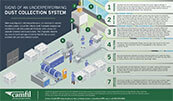Downtime caused by neglected dust collection systems can devastate businesses, resulting in lost revenue, disrupted workflows and mounting repair costs. Beyond the immediate financial hit, such failures can compromise workplace safety, violate regulations and damage a company’s reputation due to missed production deadlines.
Dust collectors are vital to maintaining a safe and efficient work environment, yet, despite their importance, maintenance is often treated as an afterthought. However, proactive maintenance of dust collection systems shouldn’t be viewed as an unnecessary cost but rather as a strategic investment. A well-structured dust collector maintenance program extends the lifespan of your equipment and provides energy cost savings by maintaining an efficient system. It also helps ensure consistent performance, reduce emergency repair costs and improve productivity.
Read further to learn why a structured industrial dust collector maintenance program is far more effective than reactive repairs. We’ll examine the long-term benefits of investing in routine upkeep, discuss essential maintenance practices and provide insights to help you implement a comprehensive program that protects both your people and your bottom line.
Health and Safety Risks of Poor Dust Collector Maintenance
Combustible Dust Hazards
A dust explosion occurs when five critical elements come together, known as the “Dust Explosion Pentagon.” These components are:
- Oxygen
- Heat (ignition source)
- Fuel (combustible dust)
- Dispersion of dust particles
- Confinement
This combination can lead to a rapid increase in pressure and energy release, causing high temperatures and generating gases.
Maintenance Failures That Increase Explosion Risks
Several common maintenance issues can contribute to the risk of dust explosions[1]:
- Accumulation of Combustible Dust: Inadequate cleaning schedules can lead to significant surface dust buildup, which can become airborne and explosive.
- Improperly Maintained Equipment: Worn or malfunctioning components in dust collection systems can create sparks or heat, serving as ignition sources.
- Lack of Explosion Venting: Dust collectors without proper explosion venting can allow pressure to build up, leading to severe explosions.[2]
- Inadequate System Design: Systems not designed to handle the types of dust generated at a facility can fail to contain or suppress explosions effectively.
Ensuring regular maintenance and adherence to safety standards is vital to mitigate these risks. Implementing a structured maintenance program can help in early detection and correction of potential hazards, safeguarding both personnel and property.
Indoor Air Quality Hazards
Neglecting industrial dust collector maintenance can significantly degrade indoor air quality, posing serious health risks to workers and leading to substantial operational costs.
Compromised Air Quality and Health Impacts
Inadequate dust collection systems can result in the accumulation of fine particulate matter in the air, compromising indoor air quality (IAQ). Initially, workers may experience mild symptoms such as headaches, nasal congestion, coughing and eye or skin irritation, often mistaken for allergies or the common cold. These afflictions can be difficult to attribute to IAQ. If employees notice improvement after leaving the facility, then those symptoms might be related to poor IAQ in the workplace.
However, long-term exposure to hazardous substances like silica and hexavalent chromium can lead to serious health conditions, including silicosis, chronic respiratory diseases and even cancer. These afflictions may surface years after exposure has occurred.
Adding to the concern are airborne vapors and particles from polyfluoroalkyl substances (PFAS), commonly referred to as “forever chemicals,” which present emerging health risks.[3], [4]
Cross-Contamination in Sensitive Environments
In industries like pharmaceuticals and food processing, inadequate dust control can lead to cross-contamination, compromising product integrity and safety. Airborne dust particles can carry allergens, pathogens or other contaminants that may compromise product integrity.[5], [6]
Economic Consequences of Poor Dust Management
Poor IAQ has a direct impact on health and productivity within the workplace. Beyond physical health effects, unhealthy IAQ also has a profound impact on workplace performance. Reduced air quality can diminish focus, increase fatigue and ultimately lower employee productivity, emphasizing the need for effective air quality management.
Investing in regular dust collection system maintenance is not just a compliance measure but a strategic decision to protect employee health and ensure operational efficiency.
Compliance With Standards and Regulations
A properly designed and maintained dust collection system is essential for facility managers to ensure compliance with workplace safety standards and combustible dust regulations.
One of the key safety standards for managing combustible dust is NFPA 660: Standard for Combustible Dusts and Particulate Solids. Officially effective as of December 6, 2024, NFPA 660 consolidates several dust-related standards from the National Fire Protection Association into a single, comprehensive document. This unification simplifies compliance and offers a clearer, more cohesive approach to managing combustible dust hazards across various industries.
NFPA 660 aims to streamline safety practices related to combustible dust while maintaining a strong connection with OSHA and other regulatory bodies. This alignment plays a crucial role in guiding enforcement, compliance strategies and risk management, ensuring a safer working environment.[7]
Under the General Duty Clause (Section 5(a)(1)) of the OSH Act, employers must provide a workplace free from recognized hazards.[8] OSHA can cite facilities for combustible dust hazards under this clause, and NFPA 660 serves as a unified benchmark. Also, OSHA’s Combustible Dust National Emphasis Program (NEP) often uses NFPA standards during inspections and enforcement actions.
The International Fire Code (IFC) and International Building Code (IBC) use NFPA standards for combustible dust hazards. In addition, insurance providers may also require NFPA 660 dust collector compliance as part of risk underwriting or loss prevention criteria.
Benefits of a Proactive Maintenance Plan
Implementing a proactive plan for your dust collection system maintenance is a critical investment in safety, efficiency and long-term performance. By scheduling regular inspections and staying ahead of potential issues, facilities can reduce the risk of accidents, lower operating costs and avoid costly downtime. In addition to enhancing workplace air quality, proactive maintenance ensures your system operates at peak performance, supporting both compliance and productivity goals.
Enhanced Safety
Regular inspections and maintenance prevent hazardous dust buildup and reduce the risk of fires and explosions. Systems such as explosion vents, isolation dampers and spark detection systems are essential components of a safety-focused maintenance routine.
Cost Efficiency
A well-maintained dust collection system operates more efficiently, reducing energy costs and prolonging the lifespan of the equipment. Replacing worn-out components like solenoids, diaphragm valves and filter regulators during routine checks prevents costly breakdowns.
Operational Continuity
Downtime due to equipment failure can significantly impact productivity. Regular maintenance minimizes unexpected interruptions and ensures consistent system performance.
Improved Air Quality
Cleaning and maintaining the system’s filter housing, inlet duct and fan components help maintain optimal airflow and clean air output, protecting workers from airborne contaminants.
Key Components of a Dust Collector Maintenance Program
A comprehensive industrial dust collector maintenance program is a strategic approach to maximizing system performance and ensuring worker safety. Each component of the system, from the cleaning mechanism to the fan and motor assembly, plays a vital role in maintaining optimal airflow and effective particulate capture. On-site training on equipment with owners and maintenance personnel also helps with knowledge of how the machine should operate on a daily basis. Routinely inspecting and servicing these key elements, facility managers can catch issues before they escalate. Here are the essential maintenance areas and actionable checklists to keep your dust collection system running at peak efficiency.
Cleaning System Maintenance
The cleaning system is the heart of a dust collector, ensuring that filters remain unblocked and operational. Regular maintenance of solenoids, diaphragm valves and compressed air systems is essential to prevent performance degradation, unscheduled downtime and increased operating costs.
Checklist:
- Solenoids
- Diaphragm valves
- Controller operation
- Air pressure settings
- Filter regulator clean-out
- Air line leakage
- Moisture inspection
Filter Housing Inspection
The filter housing serves as the structural backbone of a dust collection system, enclosing the filtration components and directing airflow through the proper channels. Over time, it can become susceptible to wear from abrasive dust, air leaks and inefficient dust discharge. Regular inspection of the housing is essential to ensure system integrity, maintain proper filtration performance and protect workers’ safety.
Checklist:
- Abrasion issues
- Door gaskets
- Clean air plenum for dust
- Cam bar operation
- View filters for abrasion
- Clean spark baffles/inlet baffles
- Vent seal and perforations
- Inlet cleanliness
Inlet Duct Monitoring
The inlet ductwork of a dust collection system plays a critical role in transporting contaminated air to the collector for filtration. Over time, however, this ducting can become partially or fully obstructed by accumulated dust, especially in systems handling heavy or sticky particulate matter. If left unchecked, this buildup can reduce airflow efficiency, increase system pressure and ultimately impair overall performance.
Checklist:
- Dust accumulation
- Leaking
- Cleanliness
Safety Equipment Verification
In industrial environments where combustible dust is present, safety equipment is essential. Dust collectors must be equipped with specialized safety features designed to mitigate the risks of fire, explosion, personnel injury and equipment damage. Routine verification of components such as explosion vents, isolation dampers and fire suppression systems is vital to ensure they function correctly in the event of an emergency.
Checklist:
- Factory certified to service
- Explosion vents
- Isolation dampers
- Spark detection systems
- Fire suppression systems
- Explosion isolation systems
Fan and Motor Maintenance
The fan and motor assembly is the driving force behind a dust collection system, maintaining the airflow necessary to capture and transport airborne particulates. To ensure consistent system performance and energy efficiency, regular maintenance of these components is essential. Neglecting fan and motor upkeep can lead to reduced suction, overheating, increased energy consumption and even complete system failure.
Checklist:
- Blower amperage draw
- Belt replacement and tension checks
- Grease bearings
- Damper settings
- Air flow and performance
Camfil APC Preventative Maintenance Solutions
Staying ahead of maintenance challenges is one of the smartest ways to ensure your dust collection system operates at peak performance, and that’s where Camfil APC’s Preventative Maintenance Solutions come in. Whether you operate a Camfil APC dust collector or a system from another manufacturer, Camfil offers tailored service plans designed to keep your operation running clean and efficiently.
With dust collector preventative maintenance support from Camfil APC, you get more than just routine checkups. Our service specialists work closely with your team to address your system’s specific needs — from filter changes and disposal to detailed inspections that identify moisture or contamination from foreign materials. These aren’t just surface-level reviews. Depending on your facility and process, technicians can also perform system balance evaluations, airflow measurements and even leak trace testing to identify and address issues before they become costly problems.
Whether you’re managing a single collector or a complex network across multiple sites, the team can customize a plan that fits your operational schedule and compliance goals.
Get in Touch With a Regional Specialist
Camfil’s expert support teams are available across the U.S., including dedicated contacts for the Northwest and Northeast territories:
Northwest Territory (Serving Northwestern U.S. and Alaska)
Email:
Service Line: 307-461-3116
Northeast Territory (Serving New England and Surrounding Areas)
Email:
Service Line: 603-400-5182
[1] Combustible Dust in Industry: Preventing and Mitigating the Effects of Fire and Explosions, https://www.osha.gov/publications/shib073105
[2] Combustible Dust: Does your company or firm process any of these products or materials in powdered form? http://osha.gov/sites/default/files/publications/combustibledustposter.pdf
[3] Identify and Improve Poor Indoor Air Quality in Manufacturing Facilities, https://camfilapc.com/blog/identify-and-improve-poor-indoor-air-quality-in-manufacturing-facilities/
[4] Improving Industrial IAQ, https://camfilapc.com/blog/improving-industrial-iaq-key-takeaways-from-camfil-on-the-engineering-influence-podcast/
[5] Meeting growing API and CDMO production demands with dust collection systems, https://www.nxtbook.com/comparenetworks/TabletsCapsules/tablets-capsules-sept-oct-2024/index.php#/p/8
[6] Can it happen here? Dust hazards at food processing facilities, https://www.processingmagazine.com/material-handling-dry-wet/dust-control/article/21253163/camfil-air-pollution-control-can-it-happen-here-dust-hazards-at-food-processing-facilities
[7] Understanding NFPA 660: The New Standard for Combustible Dust Safety, https://camfilapc.com/blog/understanding-nfpa-660-the-new-standard-for-combustible-dust-safety/
[8] What is the OSHA General Duty Clause? https://www.osha.com/blog/general-duty-clause





